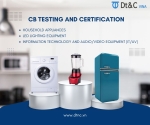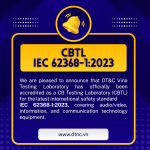Regulations on the following segments:
- Toys
- Pyrotechnics
- Recreational craft and personal watercraft
- Simple pressure vessels
- Electromagnetic compatibility
- Non-automatic weighing instruments
- Measuring instruments
- Measuring container bottles
- Lifts
- Equipment for potentially explosive atmospheres (ATEX)
- Radio equipment
- Pressure equipment
- Personal protective equipment (PPE)
- Gas appliances
- Machinery
- Equipment for use outdoors
- Aerosols
- Low voltage electrical equipment
There are different rules for medical devices, construction products, slings, transportable pressurized equipment, drone systems, railway products, marine equipment, and eco design.
CE marking is required for many products. The purpose of the CE marking is:
- Show that the manufacturer has checked that these products meet EU safety, health or environmental requirements.
- As an indicator of a product's compliance with EU legislation.
- Allows free movement of products within the European market.
By placing the CE marking on the product, the manufacturer is declaring, under its sole responsibility, to comply with all legal requirements for obtaining the CE marking. Therefore, the manufacturer is guaranteeing the validity of that product to be sold throughout the EEA. This also applies to products manufactured in third countries sold in the EEA and Türkiye.
Note: The CE marking does not mean that a product is made in the EEA, but does say that the product is evaluated before being put on the market. It means the product meets the legal requirements to be sold there. It means that the manufacturer has checked that the product complies with all relevant essential requirements, such as health and safety requirements.
It is the responsibility of the manufacturer to: Carry out conformity assessment, establish technical documentation, issue EC Declaration of Conformity (DoC), label CE.
If you are a distributor, you must check for the presence of the CE marking and necessary supporting documents.
If you are importing a product from a third country, you must check that the manufacturer outside the EU has taken the necessary steps, the documents are available.
Products that need CE marking
Even if your product is manufactured outside of the EEA, you must ensure that the product carries the CE marking if your product falls within the scope of a directive requiring the CE Mark. Not all products sold in the EU require a CE marking.
The CE marking applies to products ranging from electrical appliances to toys and from civil explosives to medical equipment. Here is the complete list of these product categories:
- Active implantable medical devices
- Appliances burning gaseous fuels
- Cableway installations designed to carry persons
- Eco-design of energy related products
- Electromagnetic compatibility
- Equipment and protective systems intended for use in potentially explosive atmospheres
- Explosives for civil uses
- Hot-water boilers
- Household refrigerators and freezers
- In vitro diagnostic medical devices
- Lifts
- Low voltage
- Machinery
- Measuring instruments
- Medical devices
- Noise emission in the environment
- Non-automatic weighing instruments
- Personal protective equipment
- Pressure equipment
- Pyrotechnics
- Radio and telecommunications terminal equipment
- Recreational craft
- Safety of toys
- Simple pressure vessels
CE marking is not required for items, for example:
- Chemistry
- Medicine
- Cosmetics and food
The CE marking process, depending on the product type, is basically as follows:
1. Identification of the directive(s) and harmonized standard(s) applicable to the product
There are more than 20 directives setting out categories of products that require CE marking. The essential requirements that products must meet, for example safety, are created at the EU level and are specified in the general terms in these directives. Harmonized European standards are issued with reference to the applicable directives and express essential safety requirements in detailed technical terms.
2. Check for product-specific requirements
It is your responsibility to ensure that your products comply with the essential requirements of the relevant EU legislation. The use of harmonized standards remains voluntary. You may decide to choose other ways to meet these essential requirements. If you do not follow the safety requirements of the standard as written, you will need to prove that your product is safe by presenting relevant documents.
3. Determine if an independent conformity assessment is required from the designated entity
Each directive covering your product specifies whether an authorized third party (Certified Body) must participate in the conformity assessment process required for CE marking. This is not required for all products, so it is important to check whether the involvement of a designated authority is required. These bodies are authorized by national authorities and are officially 'notified' to the European Commission and are listed on the NANDO (Nominated and Notified Organizations) database new approach).
UK conformity assessment bodies can no longer carry out mandatory conformity assessments on products placed on the EU market.
4. Test the product and check its conformity
If you manufacture a product, it is your responsibility to test the product and check its conformity with EU legislation (conformity assessment process). As a general rule, part of the process is a risk assessment. By applying the relevant harmonized European standards, you will be able to meet the essential legal requirements of the directives.
5. Drafting and archiving necessary technical documents
If you manufacture a product, you need to establish technical documentation as required by the directive(s) to assess the product's conformity to relevant requirements and to assess risks. You must be able to present technical documentation and EC DoCs to the relevant national authorities, if required.
6. Put CE marking on your products and EC Declaration of Conformity
The CE marking must be placed on the product by the manufacturer or by their authorized representative in the EEA or Türkiye. It must be placed in its legal format for the product or its data sheet. It should be clear, legible, and indelible. If the specified unit is involved in the production control phase, its identification number must also be displayed. It is the responsibility of the manufacturer to draw up and sign an 'EC DoC' proving that the product meets the requirements. That's it, your CE marked product is ready for the market.
Use CE mark
Once you have met the conformity assessment requirements for the CE marking, you must affix the CE marking to the product or its packaging. There are specific rules for using the CE marking on your products, as well as rules for copying the CE marking symbol. In general, you should affix the CE marking to the product itself, but it can also be placed on the packaging, in the user manual, and on other supporting documents. The rules for using the CE marking vary depending on the specific EU directive that applies to the product, and you should study applicable guidance. All of the following general rules apply:
- The CE marking is placed only by you - as the manufacturer - or your authorized representative
- CE marking cannot be placed on products that are not covered by the relevant European directives
- When affixing the CE marking, you are solely responsible for your product's compliance with the requirements of the relevant directives
- You may only use the CE marking to demonstrate the product's conformity with the relevant directives
- You must not place any sign or sign that may cause a third party to misinterpret the meaning or form of the CE mark
- Other marks placed on the product are not CE-masked
Member States will ensure that they implement a regulatory regime for CE marking. They will take appropriate action in the event of improper use of the mark and issue penalties for violations, which may include criminal sanctions for serious violations. Such penalties will correspond to the seriousness of the offence, and constitute an effective deterrent to improper use.
Design rules for CE marking
Depending on the specifics of the directive that applies to your product, you must ensure that:
- Abbreviation 'CE' in standard, recognizable form
- If you reduce or enlarge your markup size, the CE letters should correspond to the standard version
- CE marking of at least 5 mm - unless a larger minimum size is specified in the relevant directive
- The CE marking is placed on the product or on its data sheet - if this is not possible or not covered by the warranty because of the nature of the product, it must be placed on the packaging and accompanying documentation
- The CE marking is easily visible, legible and permanent
Maintain CE-related documents
You must keep certain documents after you have affixed the CE marking on your product. The market watchdog may request this information at any time to check if the CE marking has been legally placed on the product. The information you retain will vary depending on the specific directives related to your product. You must keep general records of:
- How is the product manufactured?
- How the product conforms to the relevant national standards
- Address of production and storage
- Product design and manufacture
- What new approach directives apply to the product and how have they been met?
- Community Type Check Certificate, if any
Note: You should keep the information in file form so that it can be made available if required by law enforcement.
Declaration of Conformity (DoC)
The EC DoC is a document that may be required to accompany the product. In this document, the manufacturer or their authorized representative in the EEA should: indicate that the product meets all necessary requirements of the directives applicable to the particular product, ensure that it contains the name and address of the manufacturer along with product information, such as brand and serial number, the DoC must be signed by an individual working for the manufacturer or their authorized representative and indicate the function of that employee.
For more information, please contact Dt&C VINA via email: info@dtnc.vn or hotline: 0862.619.168








![[MIC] Officially issued QCVN 134:2024/BTTTT - National technical regulation on specific absorption levels for handheld and body-worn radio devices according to Circular 19/2024/TT-BTTTT of Ministry of Information and Communications](https://cdn0577.cdn4s.com/thumbs/qcvn-134_thumb_150.jpg)



![[Latest] Circular 02/2024/TT-BTTTT regulating the List of potentially unsafe products and goods under the management responsibility of the Ministry of Information and Communications](https://cdn0577.cdn4s.com/thumbs/trang-huy-hieu-the-loai-logo-2_thumb_150.jpg)
